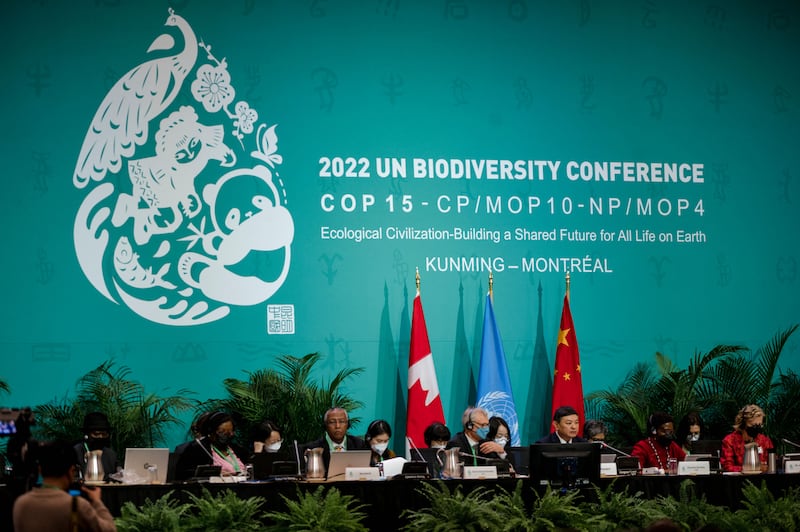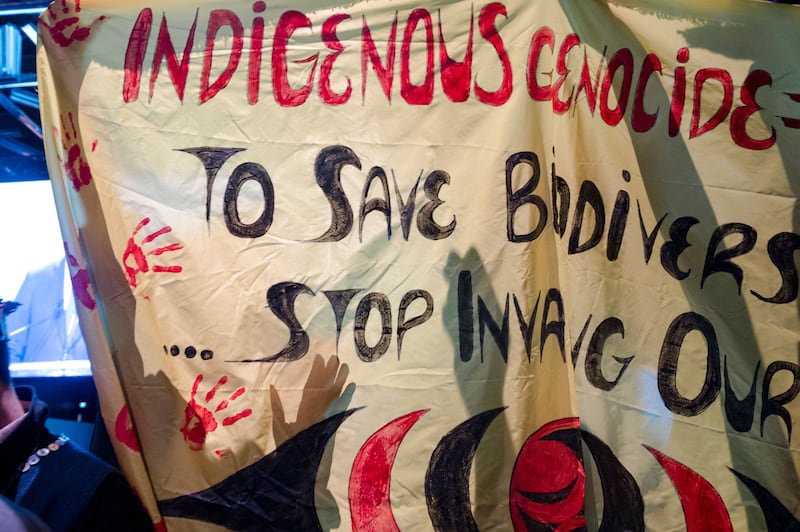Global leaders have been accused of giving in to political expediency rather than ensuring life on Earth is adequately protected by committing to a robust Cop15 agreement.
As negotiations in Montreal, Canada, appear to have already hit a wall, a petition backed by 3.2 million citizens worldwide called for a more ambitious target of at least 50 per cent conservation and protection of lands and oceans by 2030.
More than 110 countries out of almost 200 meeting in Montreal have backed a 30 per cent figure for protecting lands and oceans. A final agreement is due to be completed on December 19th.
[ Dáil housing motion forces Minister to cut short trip to Cop15 biodiversity talksOpens in new window ]
Speaking at a press briefing on Friday, Amy Lewis of the Wild Foundation recalled she was told over a decade ago she would be laughed at if she called for protection of 50 per cent of the world’s lands and seas by 2030, but science was indicating this was now urgently required.
Russia regains influence in its ‘near abroad’ as West wraps itself in red lines
‘They just want us to work and have babies.’ Exasperation in China as Halloween falls foul of authorities
Tories shout ‘we told you so’ after Rachel Reeves’ tax-and-spend Labour budget
How Trump allies could challenge US presidential election result
It was demotivating for biodiversity campaigners and young activists, she added, to see politicians calling for 30 per cent protection by the end of the decade, as by their actions they were saying “political expediency is more important than life on Earth”, she believed.
Ms Lewis said she always described this weak response as “reverse Viagra for conservation”.
The petition backing a 50 per cent target is led by prominent biodiversity NGOs who argue what is known as the 30x30 target, conceived in the drafting negotiation process between 2019 and early 2020, “is now an outdated figure based on the latest understanding of science and technology”. The call has been endorsed by NGOs including Wild, One Earth, and Grounded.
There is a feeling that biodiversity is not being prioritised at political level. I think that is an undeniable reality, because you can see the lack of world leaders
— Padraic Fogarty of the Irish Wildlife Trust
The NGOs say national pledges from countries to protect 30 per cent of their own territories by 2030 are now opening a “vulnerability policy loop” in the negotiations, where countries like Brazil or Indonesia are pushing for national targets around that percentage, which would allow further destruction in biodiversity-rich nations.
Already, early reports indicate a cumbersome and contentious process at Cop15, bogged down by disagreement, reflected in hundreds of items in square brackets – ie yet to be agreed. That follows a recent UN report that showed that not a single target from the summit’s previous 2010 agreement has been met.
The targets under that agreement include protecting 17 per cent of terrestrial and inland water areas from human development by 2020, as well as establishing consensus around policies that could help curtail pesticide and plastic pollution – all while prioritising the needs of women, Indigenous groups and low-income communities.
[ Canada leads push for conservation of 30 per cent of Earth by 2030 at Cop15Opens in new window ]
Those goals remain top priorities this year in trying to forge a new global biodiversity framework, and in some cases have become more ambitious – such as the new “30×30″ effort – which according to sources close to the negotiations is making some progress.
Padraic Fogarty of the Irish Wildlife Trust, who is an observer at Cop15, said the opening days of negotiations suggested a lack of ambition, with one report describing negotiations as “a mess”.

Cop15 should have been the culmination of four years of discussions with a meeting to nail down the final few issues, he added. A particular problem was the absence of any obvious global biodiversity targets in the way 1.5 degrees was critical in the climate context, Mr Fogarty said.
If a series of biodiversity targets could be agreed backed by science that also respects human rights, “that would be a great achievement”, he said.
[ Cop15: UN chief calls for end to ‘war on nature’Opens in new window ]
“There is a feeling that biodiversity is not being prioritised at political level. I think that is an undeniable reality, because you can see the lack of world leaders. Politically, it is not seen as an issue,” he added.
Negotiations on a deal to protect the Earth by 2030 are woefully behind in addressing the concerns of native people, whose land holds the majority of the world’s remaining biodiversity, indigenous advocates claimed.
Indigenous peoples’ participation is seen as key to reaching that so-called “30x30″ target within an ambitious new agreement to halt further nature loss and degradation.
While indigenous groups account for about 5 per cent of the world’s population, their lands safeguard about 80 per cent of Earth’s remaining plant and animal species, according to the World Bank.
The good old ways of ‘we decide what we want, and we don’t care what the indigenous want’ is becoming more and more a thing of the past
— Canada’s minister for environment Steven Guilbeault
At least 40 per cent of the world’s remaining plant species are in trouble. The global insect population is declining at an unprecedented rate of up to 2 per cent per year.
“This process around biodiversity needs to put Indigenous people at the centre,” said Dinamam Tuxa, a lawyer for Brazil’s largest indigenous umbrella group, the Articulation of Indigenous Peoples of Brazil.
While indigenous groups in many countries have only limited authority or recognition over their territories, they often rely on these environments for their livelihoods – through traditional hunting, fishing or harvesting materials from forests such as honey, rubber sap or firewood.

However, many of these territories are under increasing pressure due to weak conservation laws and growing demand for natural resources such as metals.
Indigenous groups have raised a range of concerns at Cop15. While some fear the 30x30 target could be used to take away their land under the guise of conservation, others have said the 30 per cent goal is not ambitious enough.
“The states must recognise and protect their rights,” said Aquilas Koko Ngomo, spokesperson for the National Alliance for the Support and Promotion of Indigenous and Community Heritage Areas and Territories in the Democratic Republic of Congo.
“The good old ways of ‘we decide what we want, and we don’t care what the indigenous want’ is becoming more and more a thing of the past,” Canada’s minister for environment Steven Guilbeault acknowledged in an interview.
Canada has pledged more than €750 million over seven years for up to four indigenous-led conservation initiatives that could collectively protect up to one million square kilometres (386,000 square miles).






